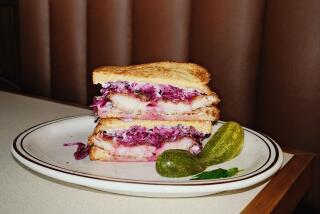A Dimpled Bread
- Share via
If you can see the world in a grain of sand, why not in a bialy? You know, those flat little rolls with the dimple in the middle that are sometimes sold at bagel stores? They might seem an unlikely subject for a serious book, but in the hands of Mimi Sheraton, they turn out to be that and more.
In “The Bialy Eaters: The Story of a Lost Bread and a Lost World” (Broadway Books, $19.95), she turns that little scrap of dough into a picture frame big enough to hold a vivid retelling of the lives of Jews in Poland, the Holocaust and the subsequent Diaspora.
The name “bialy,” it turns out, comes from “Bialystoker kuchen,” or bread from Bialystok, a town in eastern Poland near the Russian border. Before World War II, Bialystok was home to a large and vibrant Jewish community (nicknamed “Bialystoker kuchen fressers” for their affection for the breads). Today, there are no bialys to be found in Bialystok; in fact, after a century of pogroms, Nazis, Soviets and skinheads, there are only a handful of Jews.
Sheraton, former restaurant critic for the New York Times and a well-respected food journalist and cookbook author, first found bialys in Manhattan. When an assignment took her to Poland, she thought she might try them on their home ground; maybe there would be a story in it.
As it turns out, there was a much better story in their absence. Sheraton’s bialy exodus takes her to Israel, Paris and Buenos Aires, chasing down survivors of the close-knit Bialystoker community (despite their far-flung residences, there is still a regular newsletter, the Bialystoker Shtimme).
Among the people she finds are authors, bakers, lawyers, policemen, bankers and speakers of Esperanto (fittingly, the inventor of this universal language came from Bialystok). The one thing they all have in common is a memory of those crisp little rolls. “No one born in Bialystok can forget kuchen,” says one. “Rich Jews ate kuchen with meals and for poor Jews, kuchen were the meal.”
More to Read
Eat your way across L.A.
Get our weekly Tasting Notes newsletter for reviews, news and more.
You may occasionally receive promotional content from the Los Angeles Times.











